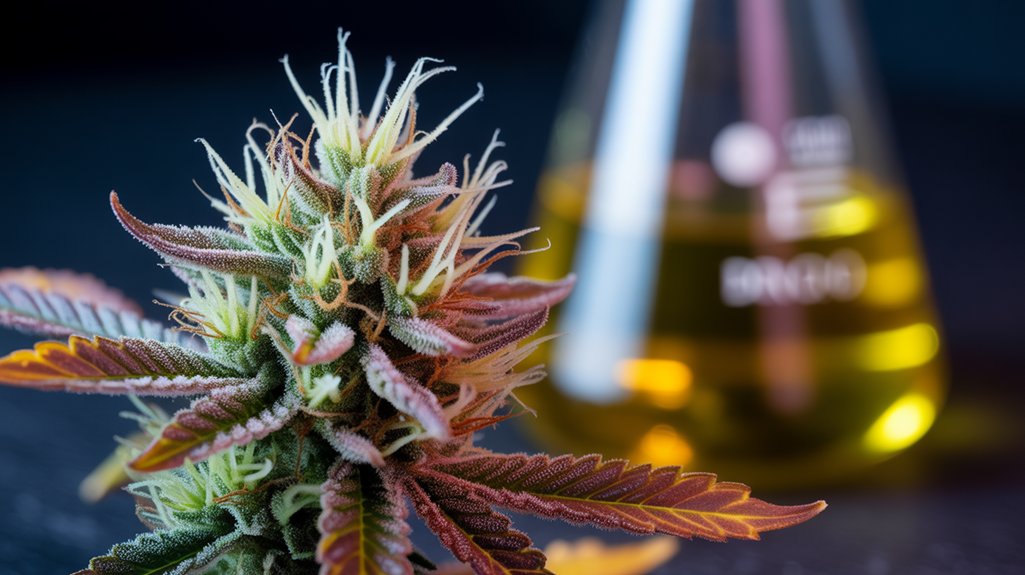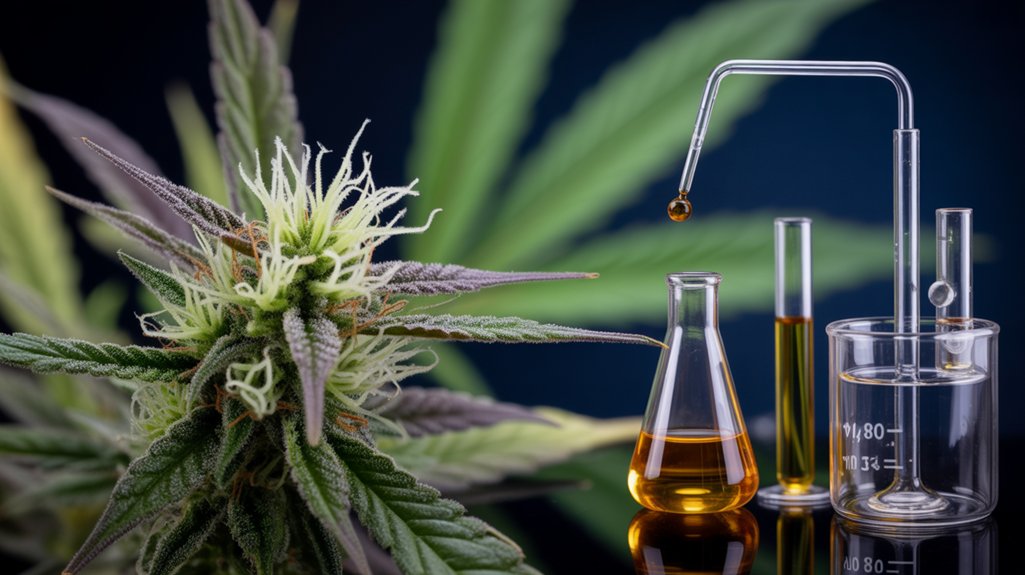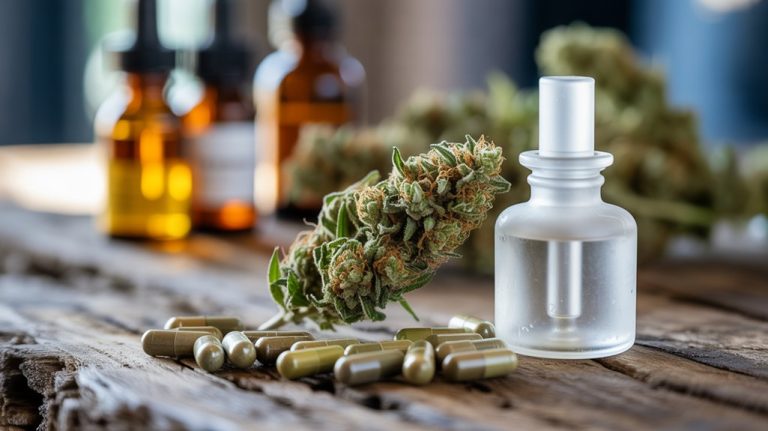You’ll encounter Delta-9 THC in two distinct forms: naturally extracted from cannabis trichomes or synthetically produced through laboratory isomerization processes. The molecular structure remains identical, but the production pathways fundamentally differ in their regulatory classifications and legal implications. Natural extraction preserves the compound’s original biosynthetic origins, while synthetic production involves chemical conversion of precursor cannabinoids like CBD. This distinction becomes essential when you’re maneuvering compliance frameworks and understanding potency variations between manufacturing methods.
What Delta-9 THC Actually Is and Where It Comes From

When you examine delta-9-tetrahydrocannabinol (Delta-9 THC) at the molecular level, you’re looking at a 21-carbon terpenophenolic compound with the chemical formula C₂₁H₃₀O₂ that serves as cannabis’s primary psychoactive constituent.
Delta 9 origins trace back to the cannabis plant’s trichomes, where specialized enzymes convert cannabigerolic acid (CBGA) into tetrahydrocannabinolic acid (THCA). This biosynthetic pathway involves THCA synthase catalyzing the oxidative cyclization of cannabigerolic acid’s precursor molecules.
The cannabinoid structure features a tricyclic core with a pentyl side chain, enabling its interaction with CB1 and CB2 receptors throughout your endocannabinoid system.
Heat exposure through decarboxylation removes THCA’s carboxyl group, converting it into the psychoactive Delta-9 THC compound you’ll find in processed cannabis products.
Natural Delta-9 THC: Direct Extraction From Cannabis Plants
Most extraction methods for natural Delta-9 THC rely on solvent-based processes that separate cannabinoids from plant matter through selective dissolution.
When you extract Delta-9 from cannabis plants, you’re utilizing the compound’s lipophilic properties to achieve isolation.
CO2 extraction employs supercritical carbon dioxide to dissolve cannabinoids while preserving their molecular integrity.
Ethanol extraction uses polar solvents to pull Delta-9 from trichome structures where it’s naturally concentrated.
Hydrocarbon extraction methods like butane or propane create non-polar environments that selectively target cannabinoid compounds.
These extraction methods maintain Delta-9’s original molecular structure as synthesized by the cannabis plant’s enzymatic pathways.
The resulting concentrate retains the same chemical composition as the naturally occurring Delta-9 THC found within the source material’s resin glands.
Synthetic Delta-9 THC: Laboratory Creation and Chemical Conversion
Laboratory synthesis of Delta-9 THC operates through controlled chemical reactions that replicate the compound’s molecular structure without requiring cannabis plant material.
You’ll find chemical synthesis employs various laboratory techniques, including cyclization reactions that form the characteristic cannabinoid ring structure.
Starting materials typically include olivetol and citral, which undergo acid-catalyzed condensation followed by decarboxylation steps.
These laboratory techniques enable precise control over stereochemistry and purity levels that natural extraction can’t guarantee.
You can also produce synthetic Delta-9 through isomerization of CBD, converting the hydroxyl group positioning through heat and acid catalysis.
Chemical conversion pathways include oxidative cyclization and photochemical reactions.
These synthetic routes yield Delta-9 THC identical to naturally occurring compounds at molecular level.
Hemp-Derived Delta-9: Converting CBD and Other Cannabinoids
Hemp-derived Delta-9 THC production relies on enzymatic and chemical conversion processes that transform abundant CBD precursors into psychoactive compounds through controlled molecular rearrangement.
You’ll find cannabinoid conversion typically employs acid-catalyzed cyclization reactions, where CBD undergoes isomerization under specific temperature and pH conditions.
Hemp processing facilities utilize reflux systems with Lewis acids like boron trifluoride or aluminum chloride to facilitate ring closure between CBD’s phenolic groups.
During this conversion, you’re fundamentally rearranging existing molecular bonds rather than synthesizing entirely new compounds.
The process yields varying ratios of Delta-8, Delta-9, and other THC isomers depending on reaction parameters.
This hemp processing method exploits CBD’s structural similarity to THC, requiring only minor conformational changes to achieve psychoactive properties.
Legal Classifications and Regulatory Differences Between Natural and Synthetic

Federal regulators classify Delta-9 THC products based on their source material and production methods, creating distinct legal pathways that greatly impact market access and compliance requirements.
You’ll find that naturally extracted Delta-9 from cannabis follows Schedule I controls under the Controlled Substances Act, while hemp-derived Delta-9 operates within the 2018 Farm Bill’s 0.3% dry weight threshold.
Synthetic Delta-9 compounds face additional scrutiny under the Federal Analogue Act, which treats chemically manufactured substances as controlled analogues.
These legal definitions create separate regulatory frameworks for identical molecular structures.
You must navigate different testing protocols, licensing requirements, and distribution channels depending on your product’s classification.
Hemp-derived products enjoy interstate commerce privileges that synthetically produced Delta-9 typically can’t access.
Safety Considerations and Quality Control for Different Production Methods
When examining production methodologies, you’ll discover that extraction-based processes typically yield fewer contaminant risks compared to synthetic manufacturing pathways.
Natural extraction utilizes established production standards involving supercritical CO2 or ethanol-based methods, creating predictable cannabinoid profiles with minimal byproduct formation.
Conversely, synthetic routes introduce potential impurities through chemical intermediates and catalyst residues that require extensive purification protocols.
Quality assurance mechanisms differ substantially between approaches.
Natural extraction benefits from standardized botanical testing procedures, while synthetic pathways demand sophisticated analytical chemistry to verify structural integrity and eliminate trace contaminants.
You’ll need thorough chromatographic analysis regardless of production method, but synthetic delta-9 requires additional spectroscopic verification to confirm molecular authenticity.
Both methodologies necessitate rigorous testing for heavy metals, pesticides, and microbial contamination to guarantee consumer safety.
Conclusion
You’ve now mastered the molecular intricacies of Delta-9 THC’s dual identity—congratulations, you’re officially a cannabinoid taxonomist! Whether you’re extracting natural compounds through sophisticated chromatographic processes or synthesizing molecules via complex isomerization pathways, you’ll appreciate that regulatory frameworks remain delightfully inconsistent. Your newfound expertise in distinguishing naturally-derived from laboratory-synthesized Delta-9 THC will prove invaluable when maneuvering through the wonderfully contradictory legal landscape that somehow treats identical molecular structures differently.





